The scientifically proven effects of vibration massage- with clinical applications
In this summary we investigate the science behind the use of vibration massage. This helps us envisage uses and to develop protocols. ... Read Article
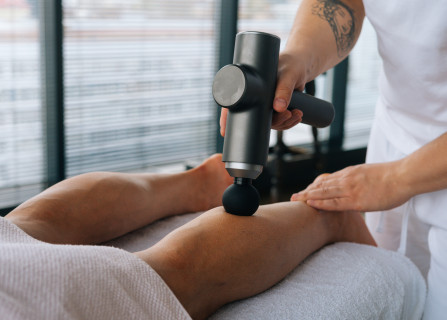
There are several reviews of trials of the use of vibrating massagers (including percussion massagers). These generally do a good job of documenting trial results, but for the reasons we will outline they are of little use for clinicians wanting to use these therapies, and can often be misleading. In this guide we use the basic sciences to dig deeper into what the trials revealed to get some useful clinical advice.
Problems with the “evidence” in the reviews
A clinically useful way to analyse the trial data
The useful clinical advice
Summaries of the individual trials
In this section:
The trials reviewed used a huge range of equipment and protocols. For example, equipment used to apply vibration ranged from powerful massage guns with 16 mm of head travel though to a vibration plate designed to stand on and a vibrator that would look at home in a toy shop.
The protocols also varied considerably including:
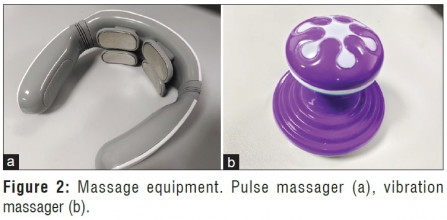
Several of the trials reviewed used very questionable choices of equipment and protocols. As an example one trial to compare stretching and vibrating massage (Gao Li1, Dan Liu1,*, 2024) used the equipment pictured. The trial was well conducted and written up, and ticked a lot of the boxes relating to validity. However, you cannot evaluate a therapy based on the performance of a piece of equipment that is obviously not a serious therapeutic device.
In another trial researchers used a hand full of short applications of a low powered massage gun over a week and concluded that percussion massage did not increase muscle size or strength (Ishikura,2024). If there were any muscle growth would take longer than one week.
The problem here is that percussion massage is a technique that attempts to combine elements of vibration massage and traditional massage (Szymczyk et al., 2022). Vibration therapy is a scientifically proven modality, while percussion (adding elements of traditional massage) is not (Bartík and Pacholek, 2024).
One of the basic goals of any trial is to eliminate the effect of all the variables apart from the one under investigation. In the case of percussion massagers there are the two potential effects:
The trials make no attempt to differentiate whether any improvement is due to the proven modality of vibration, or the percussion. Only one paper mentions this issue (but makes no attempt to address it).
”At this point, we need to divide the effect of the percussion and vibration therapy. While vibration therapy is a scientifically proven modality [2–4], PM is a considerably unexplored approach (Bartík and Pacholek, 2024)”
To analyse the results of vibration/percussion massage we need to interpret which effects have most likely contributed to the results, and how these influence the protocols that should be used. To do this we need to look at
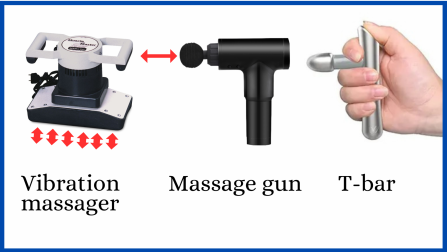
The easiest way to understand the contributions of vibration and any added elements of conventional massage is using this diagram.
The machine on the left is a vibration massager. It is designed to sit on the surface and send in large amounts of therapeutic vibrations. It has a large contact plate that goes up and down the ideal amount for vibration transfer. Note that like ultrasound (vibrations at a different frequency) these vibrations can easily penetrate deeply without the need for the head to physically penetrate.
The tool on the right is a t-bar which is used in traditional massage to help apply pressure deep into muscles.
The massage gun is an attempt to combine the two therapies. It is basically a t-bar with a jackhammer mechanism. The key is that as discussed below there is a trade off between the amount of therapeutic vibration and physical penetration.

By increasing physical penetration massage guns it lessen the amount of effective therapeutic vibration, so it is a “trade off”. Various design featured and usage protocols affect this trade off.
As an example, head number 5 in this pic would give a large amount physical penetration but would be very poor at giving therapeutic vibration. On the other hand head 1 has a larger contact area and is designed to partially collapse reducing the head movement. This gives far less physical penetration, but is a lot more effective at giving therapeutic vibrations.
To estimate the contributions of therapeutic vibration and percussion (physical penetration) for each trial we need the equipment used and protocols to estimate this trade off. Some of the things we can look at are:
As discussed above hard shaped heads give physical penetration while soft (damper) heads or flat heads are more for vibration transfer.
Powerful massage guns drive their heads in up to 16 mm which is obviously intended to for physical penetration, while the heads of vibration machines only go up and down a small amount.
The amount of penetration often depends on the pressure used. As an example in one trial of a Theragun (16mm head travel) it was stated that “continuously tolerable pressure” was used (Alvarado et al., 2022). Driving a massage gun head 16 mm forty times a second (40 Hz was used) is not tolerable and potentially damaging. Therefore the researchers minimised the pressure to allow more of the vibration effects than percussion.
Those using massage guns often move the head simulating conventional massage techniques. If done slowly this is alright, but if done quickly does not allow vibrations to “soak in” having their therapeutic effects.
Holding a massage gun with a ball head at an angle as pictured below reduces the amount of penetration, so the effect becomes more vibration.
As we have seen above one trial used a vibrator that was not a serious piece of therapeutic equipment. There is no way this would have been able to provide proper amounts of therapeutic vibration. There were also other machines of questionable merit, including the use of a vibrating platform designed to stand on rather than directly apply vibrations.
At higher levels of penetration it becomes uncomfortable and potentially unsafe to use optimum therapeutic vibration speeds speeds.
As an example 50 Hz gives an excellent increase in circulation which lasts for about 30 minutes after the vibration is removed. By contrast the slower speed of 30 Hz gives lesser increase that only lasts a much shorter time (Maloney-Hinds, Petrofsky and Zimmerman, 2008). However, driving the head of a massage gun up to 16 mm into your muscles 50 time a second would be painful and potentially damaging, so Theraguns are limited to 40 Hz, but even that is too fast. A survey of professionals found that most professionals used their massage guns on “slow” or “medium” (Cheatham et al., 2021).
The trade off seen in the trials
In the clinical trials summarised below we see that in most of the trials scientists skewed the equipment configuration and protocols so trade off was towards vibration rather than physical penetration. They would have done this because their preliminary research would have shown that this would be more effective.
Only a hand full of researchers followed the massage gun marketer narrative of physical penetration adding extra benefits. Their results were poor.
The way “vibration” and “percussion” are used varies widely, so for this we use the following definitions.
We were able to find over 30 relevant trials. We analysed these results based on the method described, and combined this with the well understood benefits of vibration massage as described in The scientifically proven effects of vibration massage- with clinical applications .
In this section:
Analysis of the trial results conclusively shows that it is the vibrations that produce the worthwhile therapeutic effects. Percussion does not appear to add any significant benefits, while as discussed above the trade off reduces the amount of therapeutic vibrations. The key findings supporting this conclusion are:
While we do not deal directly with safety here the trade off to provide physical penetration does have safety risks, as discussed in Are massage guns safe .
While any benefits of percussion are dubious and protocols are not established, the science of using therapeutic vibrations is well understood. For protocols and advice on equipment for using this therapy please see Vibration massage usage guide .
This trial compared using a massage gun vs rest for post exercise recovery, investigating perceived recovery and lactate clearance in the muscles. No difference was found.
They used a massage gun (details unavailable) at 53 Hz moving along the muscles. In the trial the massager appeared to be moved rather than remain static allowing the vibrations to “soak in”, making the predominant effect likely to be percussion.
This trial was done to investigate the effects of percussion on passive range of motion (ROM). Passive ROM did increase.
They used a Theragun at 40 Hz, with a combination of static and moving head positioning. The researchers noted that “continuously tolerable pressure” was used. Having something driving significantly into your muscles 40 times a second is intolerable and potentially injurious. This is why most professionals use massage guns on “slow” or “medium” (Cheatham et al., 2021). By using the large ball head and restricting pressure to a comfortable level the researchers minimised the physical penetration and maximised the effects of vibration. Vibration science tells us that around 50 Hz is best for post exercise recovery, but 40 Hz should give reasonable effects.
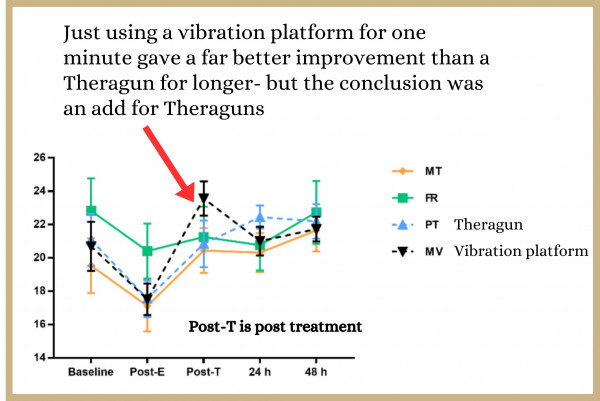
In this trial allegedly comparing vibration massage with a Theragun put vibration massage at a huge disadvantage by using inappropriate vibration equipment for a much shorter period of time. The vibration massage still gave much a much better improvement so they misrepresented the results and still used the conclusion as a sale pitch for Theraguns.
The details are that rather than a proper vibration massager they used a vibration platform designed to stand on rather than apply vibrations, then only used it for one minute. For percussion they used a Theragun for twice the time. Despite rigging the trial to give the Theragun a huge advantage as the results in the chart pictured show the vibration still gave far better results. As can be clearly seen the measurements for the Theragun group (blue line) and the vibration massage group (black line) were similar post exercise, but the vibration group had a far bigger improvement post treatment.
This trial examined whether using a percussion massager after a set of exercises would increase the number of repetitions able to be done in a subsequent set. It has the same principle author as the previously mentioned disgraceful trial, making any results suspect.
Usage did allow a higher number of subsequent repetitions. However, the massager used was a Theragun fitted with a damper head, running at 40 Hz. Damper heads are designed to minimise penetration and maximise contact for vibration transfer. Therefore the predominant therapeutic effect would have been vibration rather than percussion.
This trial investigated the effects on flexibility of vibrating massage along the paraspinal muscles, finding that flexibility was increased.
A Hypervolt massage gun with a ball head was used over a range of frequencies from 33 to 53 Hz for a total of 16 minutes. Use of the ball head would lessen physical penetration, and it appears the techniques used was designed to allow the vibrations to soak in. There would have been a mixture of vibration and percussion effects. Vibrations at these frequencies are proven to help flexibility.
This trial was to investigate the effects of percussion on the ROM and contraction strength of the calf muscles. ROM increased, but contraction strength did not.
The machine used was a Hypervolt massage gun at 53 Hz with a soft damper head. Damper heads are designed to minimise penetration while maximising vibration transfer. The predominant effect of this treatment would be vibration. 53 Hz vibration has been proven to cause relaxation in muscles.
This trial investigated the effects of percussion on chronic issues including hyperlordotic posture, pelvic inclination and (myofascial) trigger points. The results were very positive.
Treatment was given using a massage gun fitted with a “sponge probe”. The picture in the report shows this to be a large flat head with some sort of damper effect, therefore it appears that the predominant effect was vibration rather than percussion.
In this trial they used a massage gun on shoulder muscles, investigating ROM plus two more technical measurements and found that and found that those who were sore after treatment had poorer results.
This seems obvious, but there is a mentality among a lot of conventional therapists and those using massage guns that treatment needs to be painful to be effective. This trial shows that massage guns can hurt people and this results in the treatment being less effective.

This is another ridiculous and misleading trial. The researchers used the equipment pictured to investigate whether vibration or “pulsed massage” helped relax the upper trapezius muscles. There is a huge amount of work in conducting a trial and preparing a report. Because they used equipment items that were not serious therapeutic devices all that effort was wasted and any results are misleading.
This trial tested whether the application of vibration improved performance aspects such as contraction force and sprint speeds. The vibration produced significant improvements.
The equipment used was certainly vibration rather than percussion. The frequencies used were 100-180 Hz which is higher than the usual therapeutic vibration band of 30-60 Hz.
This trial found that the application of vibration accelerated recovery and helped regain lost motor capabilities fatigued by exercise. Vibration of 20- 50 Hz was used. The application head of the equipment moved only had a small amplitude (how far it goes up an down), so the effects would have been purely vibration, with no percussion.
This study investigated the effects of various types of vibrations. Their findings with regards to the effects of various frequencies are consistent with those given in our guide The scientifically proven effects of vibration massage- with clinical applications .
However, they found that for some important effects it is optimum to displace (vibrate) the muscle fibres 1-2 mm. A typical professional vibration massager will have it’s head move up and down about 5 mm. Allowing for some compression of superficial tissues these would vibrate the deeper tissues somewhere near this optimum. On the other hand a massage gun with it’s head moving 16 mm will move any tissue way above this ideal amount.
This trial used vibration to improve the ROM and reduce unwanted compensatory movements to help address the biomechanical issues that commonly occur with breast cancer. The treatment was very successful.
The equipment used was a vibration blanket at 40 Hz. There is no question that these results were 100% due to vibration, not percussion.
Impaired proprioception (your nervous system’s ability to monitor things like posture and joint positions (also known as positional sense) is a major issue with low back pain. In this study the researchers found that regular applications of vibrations helped regain this positional sense.
The researchers used a custom built vibration machine whose contact only moved up and down a small amount. There is no question that the effects were purely vibration, not percussion.
This is another completely ridiculous trial. The researchers tested whether a hand full of applications of a low powered massage gun over a week makes muscles larger and stronger. Of course if there was any effects appreciable muscle strengthening and growth it would take much longer than a week. Anyone just reading the abstract or conclusion would be badly mislead.
This study is a review of the literature relating to the use of vibrations to assist healing by increasing blood flow. They concluded low intensity vibration of around 47 Hz. For 15-30 minutes twice a day was an ideal therapy.
This eliminates percussion, as the researcher’s definition of low intensity did not include machines driving their heads in up to 16 mm.
These trials compared normal and vibrating foam rollers and found no significant difference in results. As discussed by (Poenaru et al., 2016) the vibrations need to displace muscle fibres 1-2 mm. Put simply, a low powered vibrating foam roller will not be able to displace muscle fibres that are being squashed by the roller. As confirmed by the trial results vibrating foam rollers are a gimmick with little if any therapeutic vibration effect.
This trial found that using a vibrating massager helped flexibility. We only know that the equipment used was a Chinese massage gun with a ball head running at 53 Hz. We do not know the amplitude of the head movement or whether the machine was held at an angle. We do know that Chinese massage guns are usually low powered and if it were high penetration it would be extremely uncomfortable to run at 53 Hz.
This trial used a series of 18 fifteen minute sessions of paraspinal massage at three times per week on firefighters with low back pain. It significantly improved pain and functional disability. The equipment used was a massage gun with a flat head at 30 Hz, applying no pressure other than the weight of the machine. By using a flat head with only the weight of the machine there would be little physical penetration, so the therapeutic effect would be mostly 30 Hz vibration.
While most trials concentrate on acute (shortly after treatment) effects this trial used repeated vibration therapy over time to help chronic issues. This is arguably one of the best uses of vibration therapy.
In this trial treatment was applied to muscles immediately after exercising, 24 hrs, 48 hrs and 72 hrs. ROM improve. There was little improvement in post exercise soreness, and no functional improvement. The equipment used was a massage gun with a ball head and 12 mm amplitude run at 40 Hz. This would give vibration and percussion.
Note that using the slightly higher frequency of 50 Hz immediately after exercise then daily during recovery is the excellent recommended vibration recovery protocol. Please see: The best massage for sports recovery .
This trial investigated whether percussion massage improved aspects of muscular performance. None was observed.
The equipment used was Theragun with a standard head at 29 Hz, directed perpendicularly into the muscles. With 16 mm of head travel directed straight into the muscles the effect would have been predominantly physical penetration (percussion).
In this trial a massage gun was used on calf muscles after strenuous exercise. The results were a slight increase in soreness and little effect on any of the physical measures. The machine used was a massage gun with 12mm of head travel running at 53 Hz.
Vibration at 53 Hz is proven to be very effective for helping post exercise recovery. However, significant physical penetration generally cannot be used at this frequency because of discomfort and potential injury. A survey of professionals found that most ran their massage guns at a much slower speed (Cheatham et al., 2021).
In this trial vibrating massage applied to to the muscles of the lower limb was found to improve various performance measures. The machine used was a massage gun with a flat tip running at 40 Hz. Unless a lot of pressure is used a flat head will not physically penetrate much so the predominant effect would be 40 Hz therapeutic vibration.
This trial claims to investigate the difference in effectiveness between a percussor and a hand held vibrator with respect to the symptoms of myofascial trigger points. However, the “percussor” used was a G5 stand mounted massage unit. It is noted that G5 uses the term percussion in their marketing material, but these are likely the most powerful vibration massagers on the planet. All this trial demonstrated was that the very powerful vibration massager gave better results than the less powerful one.
This is another very unhelpful trial. A combination of Theragun usage and ergonomic advice was compared with a control for back pain. There is no way of knowing whether any improvement was due to the Theragun or the ergonomic advice.
In this trial the use of a vibrating massager was found to give a similar increase in ROM as stretching exercises.
The equipment used was a massage gun with 14 mm amplitude and a hard ball head at 53 Hz. We cannot tell the contributions of vibration and percussion, but we know that significant penetration at 53 Hz would be very uncomfortable so it is likely the researchers used limited pressure and possibly angled the head.
It is known that the increase in ROM given by foam rollers is very short lived (less than 10 minutes) while the effect from static stretching lasts much longer. Only the immediate (acute effect) of the vibrating massage was measured in this trial. Most of the trials investigating ROM only measured this “acute effect” so long term benefits are generally not known.
In this trial report the “scientists” state that Upper Trapezius pain and spasm is caused by Trapezitis, an inflammation of the muscle. This is incorrect. They then say that they are testing a Theragun but the pictures show a normal configuration massage gun being used. This is an extremely poor study conducted by people who appear to not know what they are doing.
In this trial it was found that an application of vibrating massage helped increase ROM. The equipment used was a massage gun with 10 mm amplitude running at 30 Hz. The type of head used is not stated. The technique used appeared to involve a lot of static positioning, allowing any vibrations to soak in.
Massage guns with 10 mm amplitude are generally lower powered machines not capable of driving their heads in far, and the scientists appeared to use static techniques more favourable for vibration. This was likely more vibration than percussion effect.
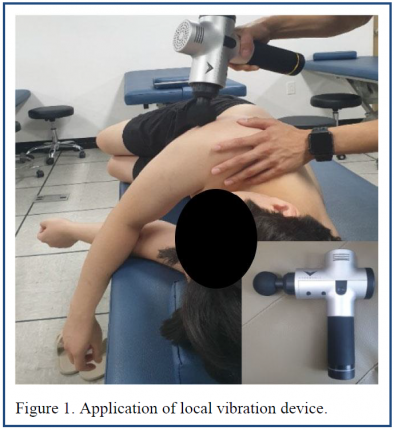
This is another trial where vibrating massage was shown to help increase ROM. This photo taken from their report demonstrates holding a percussion massager with a ball head at an angle to reduce penetration. By doing this the distance the head penetrates is reduced from possible 14-16 mm more towards the approximately 5 mm used by genuine effective genuine vibration massagers.
An analysis of the relevant trials strongly indicates that:
Given this, the best option is to use dedicate vibration massagers and vibration massage protocols. For more information on this please see the Vibration massage usage guide .

Most of our massagers genuine vibration massagers sell through colleagues using our machines and recommending the therapy to patients/clients, so we are very happy to send appropriately qualified professionals a complimentary sample machine to trial. For more info please see our Professional sample sample page .
Ahmed, S. et al. (2024) ‘The comparison of the effects of percussive massage therapy, foam rolling and hamstring stretching on flexibility, knee range of motion, and jumping performance in junior athlete: a randomized controlled trial’, Bulletin of Faculty of Physical Therapy (2024) 29:44
Alonso-Calvete, A. et al. (2022) ‘Why Percussive Massage Therapy Does Not Improve Recovery after a Water Rescue? A Preliminary Study with Lifeguards’, Healthcare (Switzerland), 10(4), pp. 1–7.
Alvarado, F. et al. (2022) ‘The Biomechanical Effects of Percussive Therapy Treatment on Jump Performance’, International journal of exercise science, 15(1) pp. 994–1006.
Ateş, R. et al. (2023) ‘A Comparison of the Acute Effects of Percussion Massage Therapy and Static Stretching on Hamstring Elasticity’, Ethiopian Journal of Health Sciences, 33(4), p. 695.
Bartík, P. and Pacholek, M. (2024) ‘The effect of percussion and manual activation massage on explosive strength and balance in young adult males : A crossover pilot study’, Heliyon, 10(20), p. e39619.
Basu, S. et al. (2019) ‘Comparative Study of Percussor vs Hand Held Vibrator in the Treatment of Comparative Study of Percussor vs Hand Held Vibrator in the Treatment of Myofascial Trigger Point on Upper Trapezius Muscle’, Indian Journal of Physiotherapy and Occupational Therapy 2019, 13(4):139
de Benito, A.M. et al. (2019) ‘Effect of vibration vs non-vibration foam rolling techniques on flexibility, dynamic balance and perceived joint stability after fatigue’, Peer J, 2019(11), pp. 1–17.
Canet‐Vintró, m. et al. (2024) ‘Effects of focal vibration on changes in sports performance in amateur athletes: A randomized clinical trial’, Journal of Orthopaedic Research, 42, pp. 2016–2115.
Cheatham, S.W. et al. (2021) ‘Mechanical percussion devices: A survey of practice patterns among healthcare professionals’, International Journal of Sports Physical Therapy, 16(3), pp. 766–777.
Chwała, W. et al. (2021) ‘Effect of vibration massage and passive rest on recovery of muscle strength after short-term exercise’, International Journal of Environmental Research and Public Health, 18(21).
Gao Li1, Dan Liu1,*, D.Y. (2024) ‘The Impact of Different Muscle Relaxation Techniques on the upper Trapezius and Its Relationship with the Middle Trapezius’, Journal of Physiological Investigation, 67(4), pp. 225–232.
García-Sillero, M., Jurado-Castro, J.M., et al. (2021) ‘Acute effects of a percussive massage treatment on movement velocity during resistance training’, International Journal of Environmental Research and Public Health, 18(15).
García-Sillero, M., Benítez-Porres, J., et al. (2021) ‘Comparison of interventional strategies to improve recovery after eccentric exercise-induced muscle fatigue’, International Journal of Environmental Research and Public Health, 18(2), pp. 1–11.
Godemeche, N. (2020) Efficacy of localized vibration massage on the flexibility of the posterior chain muscles in active adults and athletes. Fernando Pessoa University
Haba, D., Itabashi, M., Tamai, N., Tobe, H., Sanada, H. and Nakagami, G., 2024. Effectiveness of Vibration Therapy for Hard-to-Heal Wounds in Clinical Study: A Scoping Review. Chronic Wound Care Management and Research, pp.1-12.
Ishikura, H. (2024) ‘Effects of local vibration stimulation on muscle recovery and hypertrophy’, Journal of Physical Therapy Science, 36(8), pp. 441–446.
Jaskulski, K. and Zdrodowska, A. (2023) ‘The influence of percussion massage on knee ’ s range of motion in two positions Biomedical Human Kinetics, (15), pp. 181–184.
Jung, S. and Ha, S. (2020) ‘Effects of Local Vibration on Shoulder Horizontal Adduction and Internal Rotation Range of Motion in Subject with Posterior Shoulder Tightness’, Journal of Musculoskeletal Science and Technology, 4(2), pp. 66–69.
Kasahara, K. et al. (2024) ‘Comparison of acute and prolonged effects of short-term foam rolling and vibration foam rolling on the properties of knee extensors’, Biology of Sport, 42(2), pp. 19–26.
Konrad, A. et al. (2020) ‘The acute effects of a percussive massage treatment with a hypervolt device on plantar flexor muscles’ range of motion and performance’, Journal of Sports Science and Medicine, 19(4), pp. 690–694.
Leabeater, A. et al. (2024) ‘Under the Gun: Percussive Massage Therapy and Physical and Perceptual Recovery in Active Adults’, Journal of Athletic Training, 59(3), pp. 310–316.
Maloney-Hinds, C., Petrofsky, J.S. and Zimmerman, G. (2008) ‘The effect of 30 Hz vs. 50 Hz passive vibration and duration of vibration on skin blood flow in the arm(International medical journal of experimental and clinical research, 14(3), pp. CR112-6.
Mansuri, U. and Patel, S. (2021) ‘Effectiveness of Theragun and Ergonomic Advice in Patients with Low Back Pain among Bus Drivers-A Randomized Controlled Trial’, International Journal of Science and Research, 10(4), pp. 50–53
Mendes, I.D.S. et al. (2016) ‘Effects of vibration therapy in the musculoskeletal system in post‑surgical breast cancer women: Longitudinal controlled clinical study’, Revista Brasileira de Engenharia Biomedica, pp. 213–222.
Menek, M.Y. and Menek, B. (2024) ‘Effects of percussion massage therapy , dynamic stretching , and static stretching on physical performance and balance’, Journal of Back and Musculoskeletal Rehabilitation, 37, pp. 183–193.
Nakamura, M. et al. (2022) ‘Comparison of The Effect of High-and Low-Frequency Vibration Foam Rolling on The Quadriceps Muscle’, Journal of Sports Science and Medicine, 21(3), pp. 376–382.
Poenaru, D. et al. (2016) ‘Local Application of Vibration in Motor Rehabilitation - Scientific and Practical Considerations.’, Maedica, 11(3), pp. 227–231.
Roberts, T.D. et al. (2024) ‘Effects of Percussive Massage Treatments on Symptoms Associated with Eccentric Exercise-Induced Muscle Damage’, Journal of Sports Science and Medicine, (23), pp. 126–135.
Sağiroğlui, İ. (2017) ‘Acute effects of applied local vibration during foam roller exercises on lower extremity explosive strength and flexibility performance’, European Journal of Physical Education and Sport Science, 3(11), pp. 20–31.
Sakai, Y. et al. (2024) ‘Targeted vibratory therapy as a treatment for proprioceptive dysfunction: Clinical trial in older patients with chronic low back pain’, PLoS ONE, 19(7 July), pp. 1–15.
Seju, Y. and Rajput, V. (2021) ‘Efficacy of Theragun and Surge Faradic Stimulation in Subjects with Trapezitis: A Randomized Controlled Trial’, International Journal of Science and Research, 10(4), pp. 46–49.
Szymczyk, P. et al. (2022) ‘Acute Effects of Percussive Massage Treatment on Drop Jump Performance and Achilles Tendon Stiffness’, International Journal of Environmental Research and Public Health, 19(22), p. 15187.
Trainer, J.H. et al. (2022) ‘Acute Effects of Percussive Therapy on the Posterior Shoulder Muscles Differ Based on the Athlete’ , International Journal of Sports Physical Therapy, 17(5), pp. 887–895.
Welling, A. et al. (2024) ‘Investigating the Effects of Percussion Therapy on Ultrasonography-Diagnosed Thoracolumbar Fascia on Trigger Points and Hyperlordosis in Low Back Pain : A Placebo-Controlled Trial’, Altern Ther Health Med., 30(9), pp. 16–22.
Yang, C. et al. (2024) ‘Effects of percussive massage therapy on fascia echo intensity and fascia thickness in firefighters with chronic non-specific low back pain : a randomized controlled trial’, BMC Complementary Medicine and Therapies, 24, p. 390.
We are continually adding more information on research and uses. Subscribe below to have us email them to you "hot off the press".

Several years ago Dr Graeme, a Chiropractor practicing in Victoria, Australia was looking for a serious hand held massager his patients could use at home to get the extra quality massage they needed. The ones he found in the shops and on-line for home use looked nice but were not serious, and... read more
In this summary we investigate the science behind the use of vibration massage. This helps us envisage uses and to develop protocols. ... Read Article
Vibration massage has been used by professionals for decades, but more recently personal use machines have made this therapy available... Read Article
Corrective exercises are used to correct abnormal function. However, in most cases the abnormal function is the central nervous system's... Read Article
There are several reviews of trials of the use of vibrating massagers (including percussion massagers). These generally do a good job of... Read Article
Percussion massage is described as rapidly striking or applying pressure pulsations to your muscles, but this just means driving... Read Article
If you have back pain and looking for treatment the information about “misaligned vertebrae”, “bones out of place” and “subluxations” can... Read Article
Trigger points are those tender lumps in your muscles therapists find. They are arguably the biggest cause of musculoskeletal pain such... Read Article
Do not refresh or leave this page until loading complete.